Archive for the ‘Video Shooter (Book)’ Category
 The Lesson Taught & Learned
The Lesson Taught & Learned
This week I am teaching a camera storytelling workshop at the London Film School. My students enrolled in the masters program here seem motivated and especially eager to embrace my lessons of life, business, and the camera craft.
For me offering such workshops at schools and universities around the world is a way of giving back. My mentor, Albert Maysles, who died earlier this month at 88, made it a point every year to spend a few weeks sharing his prodigious expertise with aspiring young filmmakers.
I am grateful to be able to follow in my mentor’s footsteps.
Vishen Lakhiani, the great entrepreneur and founder of MindValley in Kuala Lumpur, often speaks of the threes pillars of happiness. To find happiness in our lives, he says, we need to have a wealth of experiences. We need to feel we’re growing each day. And we need to know we are contributing in some way, somehow, to the betterment of others.
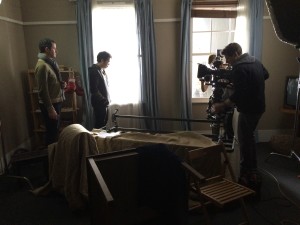
London Film School Camera & Visual Storytelling Workshop with Barry Braverman 20 March 2015
 Ruggedized LED lighting: A Welcome New Trend?
Ruggedized LED lighting: A Welcome New Trend?
Let’s hope so. Up to now, LED 1×1 arrays, even relatively pricy ones, have been constructed of cheap plastic or flimsy thin aluminum. This has posed a problem for many docco ENG type shooters who must increasingly shoot standup of a egotistical weatherman or news anchor fighting to stay upright amid the winds and driving rain of a category 5 hurricane.
Unlike previous fragilely constructed LEDs the new Lowel Prime Location bi-color LED is built like a Soviet tank. Constructed of heavy grade alloy with massive heat sinks, the fixture is all but impervious to bad weather, hurricanes, and blizzards. It is the first instrument of its kind to earn an IP65 rating, reflecting maximum resistance to damage from physical shock and water penetration, short, that is, of operating the unit underwater, which is not advised.
For non-fiction shooters the Lowel Prime Location is hopefully the harbinger of a new trend. The smoothness of an LED’s spectral output in the field is of course critical, especially with respect, say, to a reporter’s flesh tones, but any discussion of CRI and color fidelity is moot if the LED is incapable of withstanding the rigors of actual field use.

Lowel Prime Location LED
 Smaller Is Better Sometimes
Smaller Is Better Sometimes
If your bread and butter is shooting news, non-fiction, or documentaries, which covers at least three-quarters of us, a smallish-sensor camcorder fitted with a 1/3-inch, ½-inch, or 2/3-inch sensor makes a lot of sense.
Sony’s new PXW-X180 fitted with a 1/3-type sensor means in terms of imager size you can actually find and hold critical focus at the long end of its long 25X integrated zoom. I admit the whisker-thin narrow depth of field look currently in vogue offers some storytelling advantage: a blurry background with a shallow focus can help direct the viewer’s eye to what’s important inside the frame.
For documentary non-fiction shooters however our emphasis ought not to be so much on achieving the least amount of depth of field but rather how to capture the most compelling close ups. For those of us who earn a living every day in the non-fiction genre we know that close ups account for 80%-90% of our storytelling, which usually require longer focal length lenses with an inherently narrow depth of field.
Thus the full-frame sensor so ardently demanded by many shooters today may work against the exercise of a documentarian’s good craft; the extreme narrow focus in close ups may render such critical scenes objectionably soft, and thus communicate an amateurish feel to viewers.
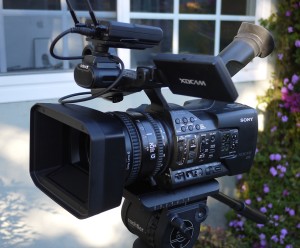
Sony’s new PXW-X180 features a very out of fashion 1/3-type sensor. Just what you may very well need for your next documentary project!
 Shooting in Near Total Darkness
Shooting in Near Total Darkness
It seems to be the latest trend among hip cinematographers. Shooting wide open with Ultra Primes or Super Speed lenses at light levels so low they barely register. Yet this is the style these days shooting in near total darkness and it is getting many DPs a lot of work.
With the advent digital cinema cameras with functional ISOs of 5000 or higher the prospect of shooting at ultra low light levels is becoming a reality. On my recent feature shoot EQUALS the young great cinematographer John Guleserian captured scenes on the sound stage with LED lighting pegged at a mere 2% on the dimmer. Yes there were flicker issues to struggle with and excruciating difficult focus to wrangle, but living on the edge delivering gutsy aggressive images at the constant risk of failure reflects in my mind a very high level of craft and confidence.
My Panasonic PX270 1/3 type camcorder shooting behind-the-scenes could not register a usable image under such low, almost-no-light conditions, but no matter the Alexa could at 1600 ISO with VERY sophisticated built-in noise reduction. And this is the key. Yes the camera optics are critical and sufficient dynamic range is essential, but it is the vast improvement in noise reduction technology that is the most main factor. The current fashion to shoot with minimal depth of field in very low light could have only been enabled by the substantially improved noise reduction algorithms.
Looking now to the 4K Varicam 35, the camera looks sensational at 5000 ISO, a legitimate rating that extends the low-light reach of shooters of feature films and high-bend projects even further. The 3X advancement in low light sensibility in a digital cinema camera means that we most likely are looking at yet another wave of projects captured still lower light levels.
Then again the alternative to ever lower light levels on sets might be simply utilizing a smaller stop so assistants can finally find and keep critcal focus especially when shooting with 85mm and 135mm lenses which is also very much in vogue. I for one would welcome this particular development as we look ahead to 4K image capture that owing to sharp focus actually looks and feels like 4K.
 LEDs Are the Future But Some Specialized LEDs Have Problems Now
LEDs Are the Future But Some Specialized LEDs Have Problems Now
The current trend to use LED lighting exclusively on feature films and high-end commercials has carried with it some interesting dichotomies. On the one hand the advent of LED instruments designed for cinema applications like the Litepanels remarkable new Astra 1×1 delivers a very bright flattering light with an exceptionally smooth color output. The RGB/RGBW LED fixtures on the other hand increasingly requested by DPs tend to be borrowed from live theater and stage. The use of such lighting for feature production introduces a bevy of potentially serious problems; the dimmed output as low as two percent in my latest project contributing to a pronounced flicker that can be most difficult to read and compensate for.
Shooting in Japan and Singapore in August and September I found myself capturing the movie’s behind-the-scenes featurette at 29.976FPS with various shutter settings of 216º, 225º, and 230º, the middle setting seeming to me especially illogical given the 50Hz operating environment. The syhchro shutter in professional cameras can of course accommodate virtually any setting no matter how weird; the real problem is addressing the other discharge lighting that may be present in a scene like the rear projection screens in my particular operating at 24FPS (actually 23.976FPS) that require a shutter of 230º, the neon, fluorescent, and even the studio house lights that require 216º, and the RGB LEDs that would strobe obnoxiously if not captured at 225º.
With new suitably designed flicker-free LED fixtures entering the market from Litepanels, Kino Flo, and others, one can finally see some hope at the end of the tunnel for keeping all of this. Once the same manufacturers introduce RGB fixtures with the same flicker free characteristics we as shooters will be finally able to escape the LED flicker menace once and for all.
After my experience over the last ten weeks I for one am eager to embrace a more orderly RGB LED shooting environment.
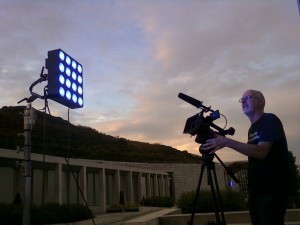
Shooting with RGB+blue LEDs is becoming increasingly common given the current trend. The potential introduction of annoying flicker is a threat that requires constant vigilance.
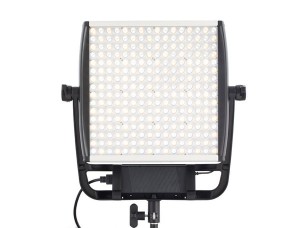
We need a wider range of flicker-free LED instruments like the new Litepanels Astra. Will the company introduce an RGB version? I hope so.
 The Demand for Uncoated Optics
The Demand for Uncoated Optics
Normally when light strikes a glass surface a portion of the beam is reflected. This loss of light is compounded in lenses with many elements, which can lead to a serious reduction in light transmission and speed. More and better lens coatings can reduce the light loss dramatically enabling lenses to maintain high speed with good resolution.
Now it may be a figment of my imagination but lately it seems more and more DPs are employing uncoated lenses. At a time when 4K and higher resolution cameras are all the rage and most shooters are indeed insisting on them it strikes me as deeply ironic and even macabre that many shooters are choosing to capture images with vastly increased flare and much much less resolution.
Of course, resolution, like wardrobe, music, and everything else, is and always has been another function of the visual story. For decades shooters used diffusion filters, metal gratings, and silk stockings, to effect a scene, to add fog or atmosphere, and yes, reduce resolution.
The great director Sidney Lumet once said that story is the conduit through which all decisions flow. The lowering of resolution is simply another storytelling device to be used and abused by shooter-storytellers of every stripe. The use of uncoated optics (as in the case of my current project shooting in Japan) is simply a reflection of this craft-oriented thinking.
 The Peril of 4K: Be Careful What You Wish For
The Peril of 4K: Be Careful What You Wish For
Higher and higher resolution. It’s what we all want, right? And the camera makers responded. NAB and Broadcast Asia 2014 were awash with 4K, and IBC will soon experience the same fate. Larger sensors and ever higher pixel counts are the rage so bring it on baby. More resolution is better, right?
Well, maybe not. The same super high resolution that lends the professional look and feel to our images has an unexpected downside. We shooters as masters of our craft have learned to compose with skill and taste, by excluding everything that detracts from the visual story.
The advent of 4K, 5K, and higher resolution has introduced an era of boundless post-camera hanky-panky, including most disturbingly the willy-nilly indelicate cropping of our well-considered images. In this new brave digital world shooters have grown accustomed of course to seeing our work tweaked ad infinitum downstream. Many scenes, say, shot on green screen, must be composited, or an image must be stabilized, or a guide wire removed. We shooters accept this reality of working in a modern all-digital world.
Problem is, owing to the arrival of 4K and heaven forbid 8K later this decade our images are being transformed and systematically trashed in a way we’ve never experienced. The shenanigans we are seeing, the re-framing and re-cropping of our work by less talented others, will only become more common as the pixel count rises. Alas giving producers, editors, and indecisive directors, so much resolution invites foul play. And that is exactly what we are increasingly experiencing.
So sure we love 4K, and more and more we are willing to put up with its challenges: the massive data loads, the high compression in-camera, the bevy of high-frequency artifacts and chromatic aberrations appearing suddenly in our re-purposed SLR lenses. Of course we love 4K. Fine. Let’s also consider the unintended consequences and the impact on our craft.
Higher and higher resolution. Is it what we really want? Think about it.
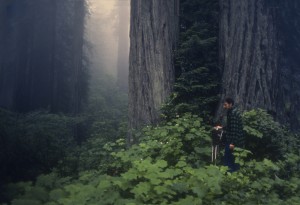
4K is growing up around us. How much resolution is enough for your stories? How much is desirable?
 A Flicker of Truth
A Flicker of Truth
Whether you’re shooting time-lapse, fast or slow motion, or even more routine scenes under temperamental fluorescent lighting, chances are you’ve confronted flicker and have thrown up your French flag in frustration. Today the flicker menace seems even greater owing to most cameras’ tiny viewfinders that make it difficult to spot on location, increased use of LEDs and other discharge lighting, and greater availability of cameras capable of shooting at off frame rates.
Flicker may be seen as a faint background pulsating effect, or more dramatically as a significant fluctuation in exposure from frame to frame. In most cases the flicker may be reduced or eliminated through use of the ClearScan or Synchroscan shutter found in newer video and hybrid cameras like the Panasonic GH4. Fine shutter tweaking should always be your first course of action. Shooting 24p in 50Hz countries? Set the camera shutter (in degrees) to 172.8º. Shooting 30p in 50Hz countries? Set the camera shutter to 108º, 216º, or 324º. The use of a camera’s fine shutter is imperative if one is to avoid flicker stemming from the field frequency mismatch when shooting abroad.
Nevertheless regardless of our best efforts the specter of objectionable flicker will occasionally raise its ugly head, and this is where Digital Anarchy’s Flicker Free plug-in can save your backside. Compatible with Final Cut Pro 7 & X, Avid, Adobe Premiere, and Adobe After Effects, the plug-in can be especially effective for eliminating flicker in time-lapse and slow-motion footage, and in certain scenes illuminated by HMIs, fluorescents, and LEDs.
The Flicker Free software is simple to use with presets for time lapse, slow motion, computer/TV screen, and archival film restoration. This level of simplicity is possible because the flicker cadence in most cases is a regular pattern. In case of need further tweaking of the underlying parameters is still possible from within the plug-in.
Flicker Free’s THRESHHOLD setting specifies how much change in brightness is tolerated from frame to frame. While significant changes in brightness from frame to frame are usually deliberate, this is not the case when shooting neon or in an out of sync 50Hz/60Hz environment. In such scenes exhibiting a brightness fluctuation in excess of 20 percent from frame to frame Flicker Free is not likely to offer much help.
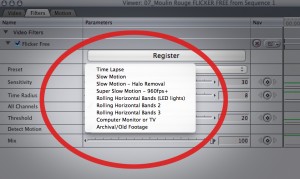
Digital Anarchy’s Flicker Free plug-in is supported in most major editing platforms. It will work either very well. Or not at all.
 Nothing Digital About This
Nothing Digital About This
Some of you may be aware that I have a vague and passing interest in vintage English bicycles manufactured from 1935 to 1950. Respected makers like Raleigh, Rudge, Humber, and Sunbeam, ruled the roost during this era of petrol rationing prior to and for several years after World War II. These bicycles were not generally well chromed or even particularly well finished. They were not works of art to be admired on a wall in a museum but were in fact heavy utilitarian beasts to be used daily in all kinds of weather for the purpose of simple transportation. This morning in London many of these humble machines from decades ago once more saw the light of day for the annual London Tweed Run. I can report that I was present and orgasmic for the entire 3.75 hours of this blessed event.
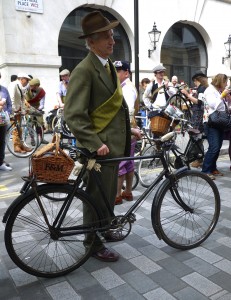
The Tweed Run London 17 May 2014
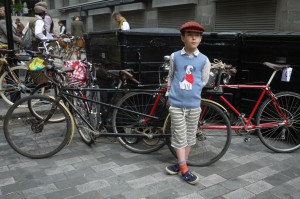
Guarding His Dad’s 1930s Era Tandem

The Tweed Run accommodated rider of all ages and species.
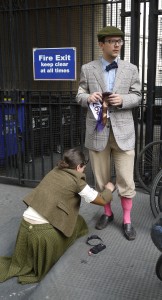
The Tweed Run attracted many couples.
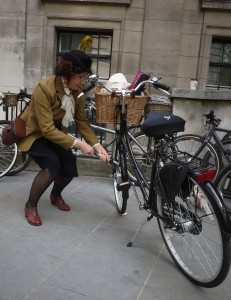
The required attire did not seem particularly conducive to performing basic bicycle maintenance.

Getting married in 1930s Britain? For most couples this meant purchasing a tandem and hitting the road.
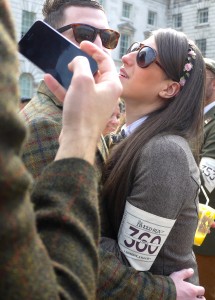
It’s difficult to imagine a more romantic setting for a young couple in love.
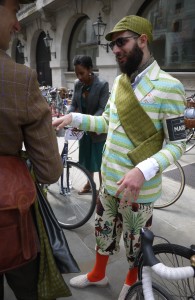
Some folks took some liberty with the event dress code.

A good motto indeed to live by in prewar Britain.
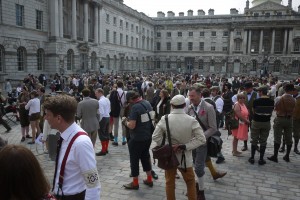
 Panasonic’s new GH4: Digital Cinema Camera By Any Other Name
Panasonic’s new GH4: Digital Cinema Camera By Any Other Name
Any way you hang it or support it the new Panasonic GH4 is an amazing camera, with true Cinema 4K (4096 x 2160) resolution, VFR 2-96 FPS, 10-bit 4:2:2 200 Mbps All-I frame FHD, plus optional 3G-SDI output and balanced XLR audio inputs. Given the hybrid camera’s latest Micro Four Thirds imager, low noise in light, and 11 stops of latitude, the produced images look a lot like what one might see in a digital cinema. The camera doesn’t feel or operate like a true digital cinema camera however. And therein lies the rub.
Cameras cannot be judged by raw performance or specifications alone. We still have to be able to handle the camera efficiently under a wide range of conditions and keep it in focus. Operational considerations matter!
Here is a link to my current review of the camera in Studio Daily Magazine:
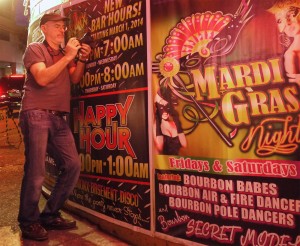
Shooting with the new Panasonic GH4. Barry Braverman seeks moral and physical support in Makati City Philippines 19 March 2014